Designing Inclusive and Adaptive Content in Moodle: A Framework and a Case Study from Jordanian Higher Education
Abstract
1. Introduction
- How can Moodle be used to support inclusive and accessible learning experiences for students with diverse needs and challenges in blended learning environments?
- What are the available features in Moodle that can promote inclusive and adaptive blended learning?
- How is the role of Moodle in inclusive blended learning perceived by educators in Jordanian higher education institutions?
- What are the challenges in investing in Moodle for achieving inclusive education, and how to deal with such challenges?
2. Literature Review and Research Background
2.1. Blended Learning and Blended Learning Models
2.2. Alternative Learning Environments to Traditional Classrooms in Education
2.3. Universal Design for Learning (UDL) and Inclusive Learning
3. Research Methodology
3.1. Research Design
3.2. Data Collection and Participants
3.2.1. Primary Sources: Teaching Reflections and Observations
3.2.2. Secondary Sources: Student and Educator Feedback
- Weekly Student Focus Groups
- 2.
- Educator Interviews
3.3. Data Analysis
3.4. Triangulation Strategy
3.5. Fundamentals of Software Engineering Course
3.6. Development of a Framework of Inclusive and Adaptive Content
3.7. Ethical Considerations
4. Results
4.1. Teaching Reflections, Focus Groups, and Interviews Codes
- Barriers for engaging learners in blended learning environments: This theme identified the challenges related to the participation and engagement of students in blended learning settings, such as the strict deadlines and content consumption levels in Moodle.
- Learning preferences and adaptive learning: This theme explains how adaptive content could enhance inclusivity in a blended learning environment.
- Educators’ perceptions of Moodle’s adaptability and inclusivity features: This theme analyses Moodle from the viewpoints of Jordanian educators.
- Educators’ readiness and preparedness: This theme focuses on the ability of educators to learn the adaptability and inclusive features available in Moodle, where it has two perspectives, namely, the usability of Moodle and the time available for educators to learn with the workload they have.
- Best practices for designing inclusive and adaptive blended learning: This theme focuses on providing recommendations for enhancing inclusivity using features available in Moodle.
4.2. Adaptive Inclusive Learning in Moodle
4.3. Inclusivity Through Project-Based Learning in Moodle
4.4. Emotional Inclusion Through Moodle
4.5. Performance Trends
4.6. Challenges
4.6.1. Content-Related Challenges
4.6.2. Accessibility-Related Challenges
5. Discussion
5.1. How Can Moodle Be Used to Support Inclusive and Accessible Learning Experiences for Students with Diverse Needs and Challenges in Blended Learning Environments?
5.2. What Are the Available Features in Moodle That Can Promote Inclusive and Adaptive Blended Learning?
5.3. How Is the Role of Moodle in Inclusive Blended Learning Perceived by Educators in Jordanian Higher Education Institutions?
5.4. What Are the Challenges in Investing in Moodle for Achieving Inclusive Education, and How to Deal with Such Challenges?
6. Conclusions, Recommendations, and Future Work
7. Limitations and Future Work
Author Contributions
Funding
Institutional Review Board Statement
Informed Consent Statement
Data Availability Statement
Acknowledgments
Conflicts of Interest
Appendix A. Interview Questions and Their Rationale
| No | Question | Rationale |
| 1 | From your experience, what does inclusive blended learning mean? And how do you define its key principles in higher education? | The first question is designed to see the level of understanding of inclusive blended learning among the participants |
| 2 | What specific tools or features in Moo-dle have you used (or are aware of) that support adaptive and inclusive learning for students with diverse learning needs? | The second question is designed to find out the level of familiarity with Moodle’s inclusive features |
| 3 | What are the key challenges you have faced when trying to create an inclusive and adaptive learning environment using Moodle? | We then wanted to know the challenges in implementing inclusive learning in Moodle |
| 4 | Based on your experience, what improvements or additional features should Moodle offer to better support inclusive and adaptive learning? | Then, we asked about the recommendations for improving Moodle’s inclusivity and adaptivity |
References
- Almaiah, M.A.; Mulhem, A.A. A conceptual framework for determining the success factors of e-learning system implementation using Delphi tech-nique. J. Theor. Appl. Inf. Technol. 2005, 96, 5962–5976. [Google Scholar]
- Anthony, B.; Kamaludin, A.; Romli, A.; Raffei, A.F.M.; Phon, D.N.A.L.E.; Abdullah, A.; Ming, G.L. Blended Learning Adoption and Implementation in Higher Education: A Theoretical and Systematic Review. Technol. Knowl. Learn. 2022, 27, 531–578. [Google Scholar] [CrossRef]
- El-Maghraby, A.-S.A. Investigating The Effectiveness of Moodle Based Blended Learning in Developing Writing Skills for University Students. J. Res. Curric. Instr. Educ. Technol. 2021, 7, 115–140. [Google Scholar] [CrossRef]
- Brandl, K. Are you ready to Moodle? Lang. Learn. Technol. 2005, 9, 16–23. [Google Scholar]
- Gökhan, A. Profiling Students Approaches to Learning through Moodle Logs. In Proceedings of the Multidisciplinary Academic Conference on Education, Teaching and Learning (MAC-ETL 2015), Prague, Czech Republic, 7–8 August 2015; MAC Prague consulting Ltd.: Chudenicka, Czech Republic, 2015. [Google Scholar]
- Morze, N.; Varchenko-Trotsenko, L.; Terletska, T.; Smyrnova-Trybulska, E. Implementation of adaptive learning at higher education institutions by means of Moodle LMS. J. Phys. Conf. Ser. 2021, 1840, 012062. [Google Scholar] [CrossRef]
- Salmi, J. Higher Education and Inclusion; UNESCO: London, UK, 2020; p. 47. Available online: https://unesdoc.unesco.org/ark:/48223/pf0000373689 (accessed on 30 May 2025).
- Al-Azawei, A.; Serenelli, F.; Lundqvist, K. Universal Design for Learning (UDL): A Content Analysis of Peer Reviewed Journals from 2012 to 2015. J. Scholarsh. Teach. Learn. 2016, 16, 39–56. [Google Scholar] [CrossRef]
- Basham, J.D.; Hall, T.E.; Carter, R.A.; Stahl, W.M. An Operationalized Understanding of Personalized Learning. J. Spec. Educ. Technol. 2016, 31, 126–136. [Google Scholar] [CrossRef]
- Mulenga, R.; Shilongo, H. Hybrid and Blended Learning Models: Innovations, Challenges, and Future Directions in Education. Acta Pedagog. Asiana 2024, 4, 1–13. [Google Scholar] [CrossRef]
- Poon, J. A cross-country comparison on the use of blended learning in property education. Prop. Manag. 2014, 32, 154–175. [Google Scholar] [CrossRef]
- Brenya, B. Higher education in emergency situation: Blended learning prospects and challenges for educators in the developing countries. JARHE 2024, 16, 1015–1028. [Google Scholar] [CrossRef]
- Ghazal, S.; Al-Samarraie, H.; Aldowah, H. “I am Still Learning”: Modeling LMS Critical Success Factors for Promoting Students’ Experience and Satisfaction in a Blended Learning Environment. IEEE Access 2018, 6, 77179–77201. [Google Scholar] [CrossRef]
- Edward, C.N.; Asirvatham, D.; Johar, M.d.G.M.d. Effect of blended learning and learners’ characteristics on students’ competence: An empirical evidence in learning oriental music. Educ. Inf. Technol. 2018, 23, 2587–2606. [Google Scholar] [CrossRef]
- Ismail, A.O.; Mahmood, A.K.; Abdelmaboud, A. Factors Influencing Academic Performance of Students in Blended and Traditional Domains. IJETL 2018, 13, 170. [Google Scholar] [CrossRef]
- Graham, C.R.; Woodfield, W.; Harrison, J.B. A framework for institutional adoption and implementation of blended learning in higher education. Internet High. Educ. 2013, 18, 4–14. [Google Scholar] [CrossRef]
- Subramaniam, S.R.; Muniandy, B. The Effect of Flipped Classroom on Students’ Engagement. Technol. Knowl. Learn. 2019, 24, 355–372. [Google Scholar] [CrossRef]
- Anthony, B.; Kamaludin, A.; Romli, A.; Raffei, A.F.M.; Nincarean, A.L.; Eh Phon, D.; Abdullah, A.; Ming, G.L.; Shukor, N.A.; Nordin, M.S.; et al. Exploring the role of blended learning for teaching and learning effectiveness in institutions of higher learning: An empirical investigation. Educ. Inf. Technol. 2019, 24, 3433–3466. [Google Scholar] [CrossRef]
- Owston, R.; York, D.N.; Malhotra, T. Blended learning in large enrolment courses: Student perceptions across four different instructional models. AJET 2019, 35, 29–45. [Google Scholar] [CrossRef]
- Alamri, H.A.; Watson, S.; Watson, W. Learning Technology Models that Support Personalization within Blended Learning Environments in Higher Education. TechTrends 2021, 65, 62–78. [Google Scholar] [CrossRef]
- Spoelstra, H.; Stoyanov, S.; Burgoyne, L.; Bennett, D.; Sweeney, C.; Drachsler, H.; Vanderperren, K.; Van Huffel, S.; McSweeney, J.; Shorten, G.; et al. Convergence and translation: Attitudes to inter-professional learning and teaching of creative problem-solving among medical and engineering students and staff. BMC Med. Educ. 2014, 14, 14. [Google Scholar] [CrossRef]
- Spring, K.J.; Graham, C.R.; Hadlock, C.A. The current landscape of international blended learning. IJTEL 2016, 8, 84. [Google Scholar] [CrossRef]
- Guillén-Gámez, F.D.; Mayorga-Fernández, M.J.; Álvarez-García, F.J. A Study on the Actual Use of Digital Competence in the Practicum of Education Degree. Technol. Knowl. Learn. 2020, 25, 667–684. [Google Scholar] [CrossRef]
- Amridinova, A. The Impact of Blended Learning on Inclusive Education. J. Lang. Pedagogy Innov. Appl. Linguist. 2024, 2, 37–43. [Google Scholar]
- Ustunel, H.H.; Tokel, S.T. Distributed Scaffolding: Synergy in Technology-Enhanced Learning Environments. Technol. Knowl. Learn. 2018, 23, 129–160. [Google Scholar] [CrossRef]
- Bishop, J.; Verleger, M. The Flipped Classroom: A Survey of the Research. In Proceedings of the 2013 ASEE Annual Conference & Exposition Proceedings, ASEE Conferences, Atlanta, GA, USA, 23–26 June 2013; pp. 23–1200. [Google Scholar]
- O’Flaherty, J.; Phillips, C. The use of flipped classrooms in higher education: A scoping review. Internet High. Educ. 2015, 25, 85–95. [Google Scholar] [CrossRef]
- Låg, T.; Sæle, R.G. Does the Flipped Classroom Improve Student Learning and Satisfaction? A Systematic Review and Meta-Analysis. AERA Open 2019, 5, 2332858419870489. [Google Scholar] [CrossRef]
- Stöhr, C.; Demazière, C.; Adawi, T. The polarizing effect of the online flipped classroom. Comput. Educ. 2020, 147, 103789. [Google Scholar] [CrossRef]
- Ifenthaler, D.; Sampson, D.G.; Spector, J.M. Interactions Between Cognitive Psychology, Educational Technology, and Computing in the Digital Age. Technol. Knowl. Learn. 2015, 20, 129–131. [Google Scholar] [CrossRef]
- Adel, A.; Dayan, J. Towards an intelligent blended system of learning activities model for New Zealand institutions: An investigative approach. Humanit. Soc. Sci. Commun. 2021, 8, 72. [Google Scholar] [CrossRef]
- Rose, D.H.; Meyer, A. Teaching Every Student in The Digital Age: Universal Design for Learning; Association for Supervision and Curriculum Development: Alexandria, VA, USA, 2002. [Google Scholar]
- Rose, D.H.; Strangman, N. Universal Design for Learning: Meeting the challenge of individual learning differences through a neurocognitive perspective. Univers. Access Inf. Soc. 2007, 5, 381–391. [Google Scholar] [CrossRef]
- Meyer, A.; Rose, D.H.; Gordon, D. Universal Design for Learning: Theory and Practice; CAST Professional Publishing, An Imprint of CAST, Inc.: Wakefield, MA, USA, 2014. [Google Scholar]
- Rusconi, L.; Squillaci, M. Effects of a Universal Design for Learning (UDL) Training Course on the Development Teachers’ Competences: A Systematic Review. Educ. Sci. 2023, 13, 466. [Google Scholar] [CrossRef]
- Lieber, J.; Horn, E.; Palmer, S.; Fleming, K. Access to the General Education Curriculum for Preschoolers with Disabilities: Children’s School Success. Exceptionality 2008, 16, 18–32. [Google Scholar] [CrossRef]
- Coyne, P.; Pisha, B.; Dalton, B.; Zeph, L.A.; Smith, N.C. Literacy by Design: A Universal Design for Learning Approach for Students With Significant Intellectual Disabilities. Remedial Spec. Educ. 2012, 33, 162–172. [Google Scholar] [CrossRef]
- Loman, S.L.; Strickland-Cohen, M.K.; Walker, V.L. Promoting the Accessibility of SWPBIS for Students With Severe Disabilities. J. Posit. Behav. Interv. 2018, 20, 113–123. [Google Scholar] [CrossRef]
- Sasson, I.; Yehuda, I.; Miedijensky, S. Innovative learning spaces: Class management and universal design for learning. Learn. Environ. Res. 2022, 25, 725–739. [Google Scholar] [CrossRef]
- Daley, S.G.; Xu, Y.; Proctor, C.P.; Rappolt-Schlichtmann, G.; Goldowsky, B. Behavioral Engagement among Adolescents with Reading Difficulties: The Role of Active Involvement in a Universally Designed Digital Literacy Platform. Read. Writ. Q. 2020, 36, 278–295. [Google Scholar] [CrossRef]
- Kennedy, M.J.; Thomas, C.N.; Meyer, J.P.; Alves, K.D.; Lloyd, J.W. Using Evidence-Based Multimedia to Improve Vocabulary Performance of Adolescents With LD: A UDL Approach. Learn. Disabil. Q. 2014, 37, 71–86. [Google Scholar] [CrossRef]
- Rogers-Shaw, C.; Carr-Chellman, D.J.; Choi, J. Universal Design for Learning: Guidelines for Accessible Online Instruction. Adult Learn. 2018, 29, 20–31. [Google Scholar] [CrossRef]
- Tlili, A.; Denden, M.; Essalmi, F.; Jemni, M.; Chang, M.; Kinshuk; Chen, N.-S. Automatic modeling learner’s personality using learning analytics approach in an intelligent Moodle learning platform. Interact. Learn. Environ. 2019, 31, 2529–2543. [Google Scholar] [CrossRef]
- Calvo, R.; Iglesias, A.; Moreno, L. Accessibility barriers for users of screen readers in the Moodle learning content management system. Univers. Access Inf. Soc. 2014, 13, 315–327. [Google Scholar] [CrossRef]
- Moreno, L.; Iglesias, A.; Calvo, R.; Delgado, S.; Zaragoza, L. Disability Standards and Guidelines for Learning Management Systems: Evaluating Accessibility. In Higher Education Institutions and Learning Management Systems: Adoption and Standardization; IGI Global: Hershey, PA, USA, 2012; pp. 199–218. Available online: https://hdl.handle.net/10016/16774 (accessed on 25 May 2025).
- Montes, R.; Herrera, L.; Crisol, E. Moodle Usability Assessment Methodology using the Universal Design for Learning perspective. arXiv 2024. [Google Scholar] [CrossRef]
- Rao, K.; Edelen-Smith, P.; Wailehua, C.-U. Universal design for online courses: Applying principles to pedagogy. Open Learn. J. Open Distance E-Learn. 2015, 30, 35–52. [Google Scholar] [CrossRef]
- Creswell, J.W.; Poth, C.N. Qualitative Inquiry & Research Design: Choosing Among Five Approaches, 4th ed.; SAGE: Los Angeles, CA, USA, 2018. [Google Scholar]
- Sharp, C.A. Qualitative Research and Evaluation Methods (3rd ed.). Eval. J. Australas. 2003, 3, 60–61. [Google Scholar] [CrossRef]
- Thompson, S.; Thompson, N. The Critically Reflective Practitioner, 3rd ed.; Bloomsbury Academic: London, UK, 2023. [Google Scholar]
- Brookfield, S. Becoming a Critically Reflective Teacher, 2nd ed.; Jossey-Bass: San Francisco, CA, USA, 2017. [Google Scholar]
- Palinkas, L.A.; Horwitz, S.M.; Green, C.A.; Wisdom, J.P.; Duan, N.; Hoagwood, K. Purposeful Sampling for Qualitative Data Collection and Analysis in Mixed Method Implementation Research. Adm. Policy Ment. Health Ment. Health Serv. Res. 2015, 42, 533–544. [Google Scholar] [CrossRef]
- Santos, K.D.S.; Ribeiro, M.C.; Queiroga, D.E.U.D.; Silva, I.A.P.D.; Ferreira, S.M.S. O uso de triangulação múltipla como estratégia de validação em um estudo qualitativo. Ciênc. Saúde Coletiva 2020, 25, 655–664. [Google Scholar] [CrossRef]
- Ellis, C.; Adams, T.E.; Bochner, A.P. Autoethnography: An Overview. Forum Qual. Sozialforschung Forum Qual. Soc. Res. 2010, 12. [Google Scholar] [CrossRef]
- Squires, V. Thematic Analysis. In Varieties of Qualitative Research Methods; Okoko, J.M., Tunison, S., Walker, K.D., Eds.; Springer Texts in Education; Springer International Publishing: Cham, Switzerland, 2023; pp. 463–468. [Google Scholar] [CrossRef]
- Braun, V.; Clarke, V. Using thematic analysis in psychology. Qual. Res. Psychol. 2006, 3, 77–101. [Google Scholar] [CrossRef]
- Farmer, T.; Robinson, K.; Elliott, S.J.; Eyles, J. Developing and Implementing a Triangulation Protocol for Qualitative Health Research. Qual. Health Res. 2006, 16, 377–394. [Google Scholar] [CrossRef]
- Nganji, J.T.; Brayshaw, M. Disability-aware adaptive and personalised learning for students with multiple disabilities. Int. J. Inf. Learn. Technol. 2017, 34, 307–321. [Google Scholar] [CrossRef]
- Universal Access Through Inclusive Instructional Design: International Perspectives on UDL; Gronseth, S.L., Dalton, E.M., Eds.; Routledge; Taylor & Francis Group: New York, NY, USA; London, UK, 2020. [Google Scholar]
- Roski, M.; Sebastian, R.; Ewerth, R.; Hoppe, A.; Nehring, A. Learning analytics and the Universal Design for Learning (UDL): A clustering approach. Comput. Educ. 2024, 214, 105028. [Google Scholar] [CrossRef]
- Al-Qora’n, L.F.; Jawarneh, A.; Nganji, J.T. Toward Creating Software Architects Using Mobile Project-Based Learning Model (Mobile-PBL) for Teaching Software Architecture. MTI 2023, 7, 31. [Google Scholar] [CrossRef]
- Hussein, M.H.; Ow, S.H.; Al-Azawei, A.; Ibrahim, I. What drives students’ successful reuse of online learning in higher education? A case of Google Classroom. AJET 2022, 38, 1–21. [Google Scholar] [CrossRef]
- Spanjers, I.A.E.; Van Gog, T.; Wouters, P.; Van Merriënboer, J.J.G. Explaining the segmentation effect in learning from animations: The role of pausing and temporal cueing. Comput. Educ. 2012, 59, 274–280. [Google Scholar] [CrossRef]
- Paas, F.; Tuovinen, J.E.; Tabbers, H.; Van Gerven, P.W.M. Cognitive Load Measurement as a Means to Advance Cognitive Load Theory. Educ. Psychol. 2003, 38, 63–71. [Google Scholar] [CrossRef]
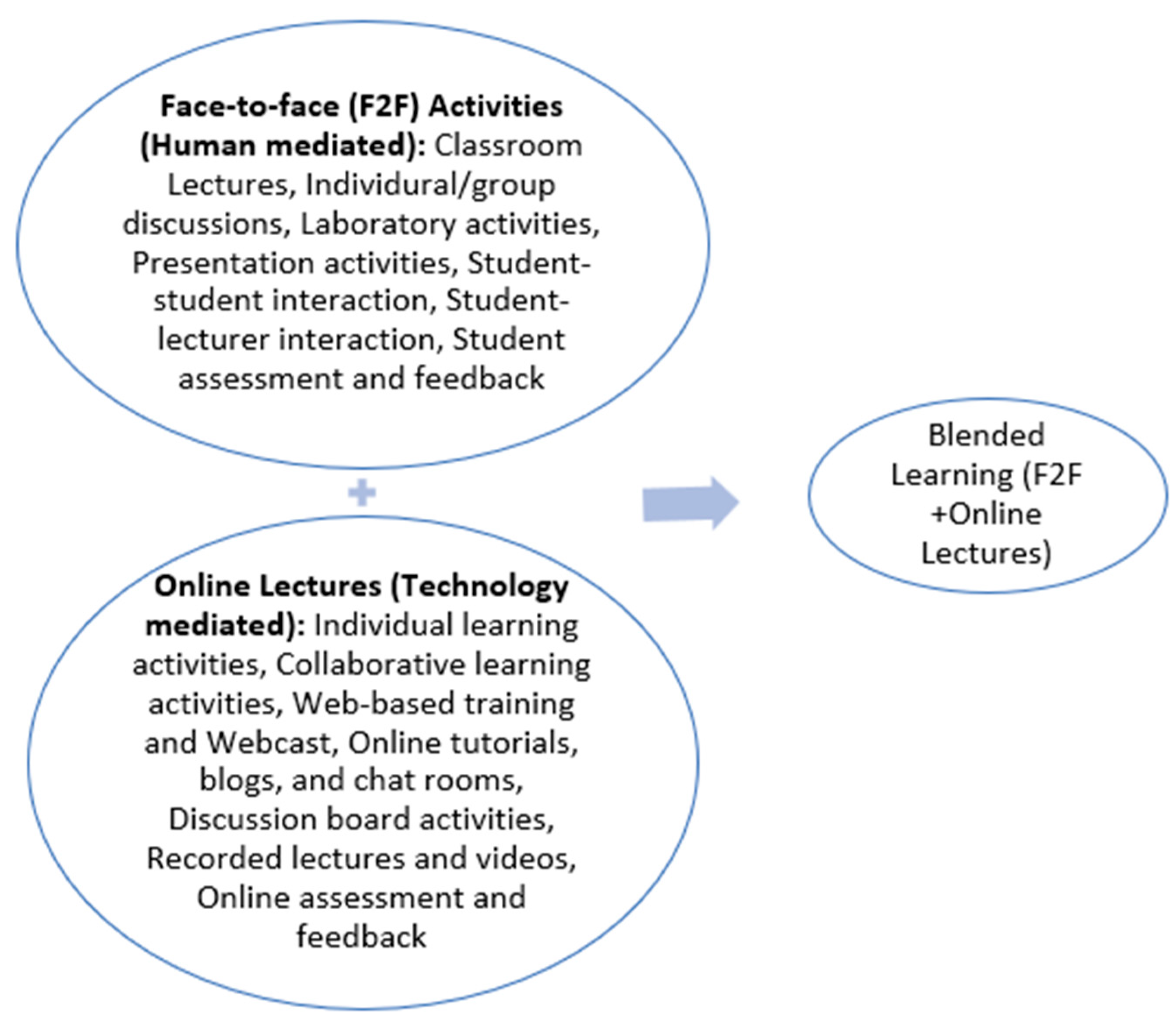
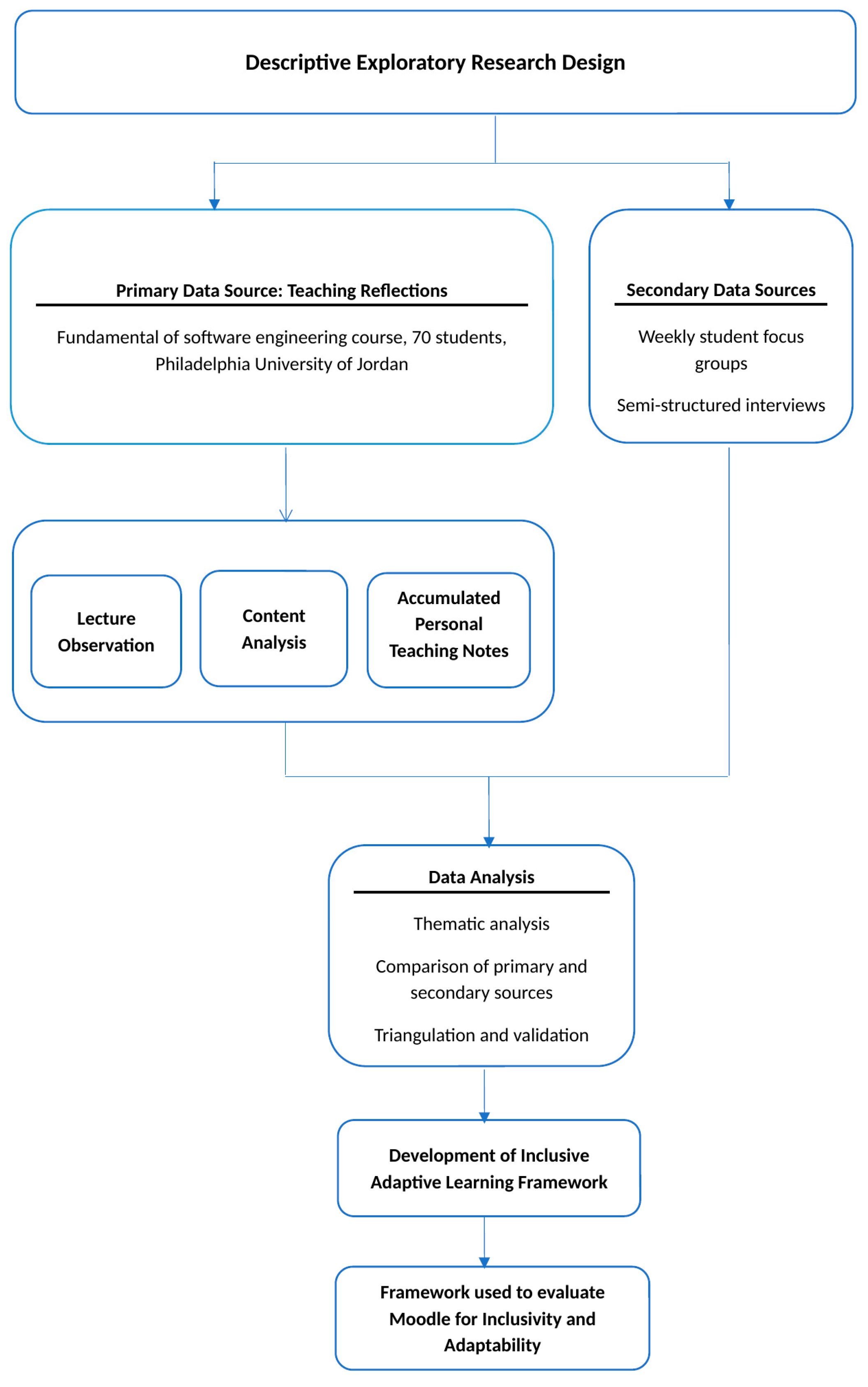
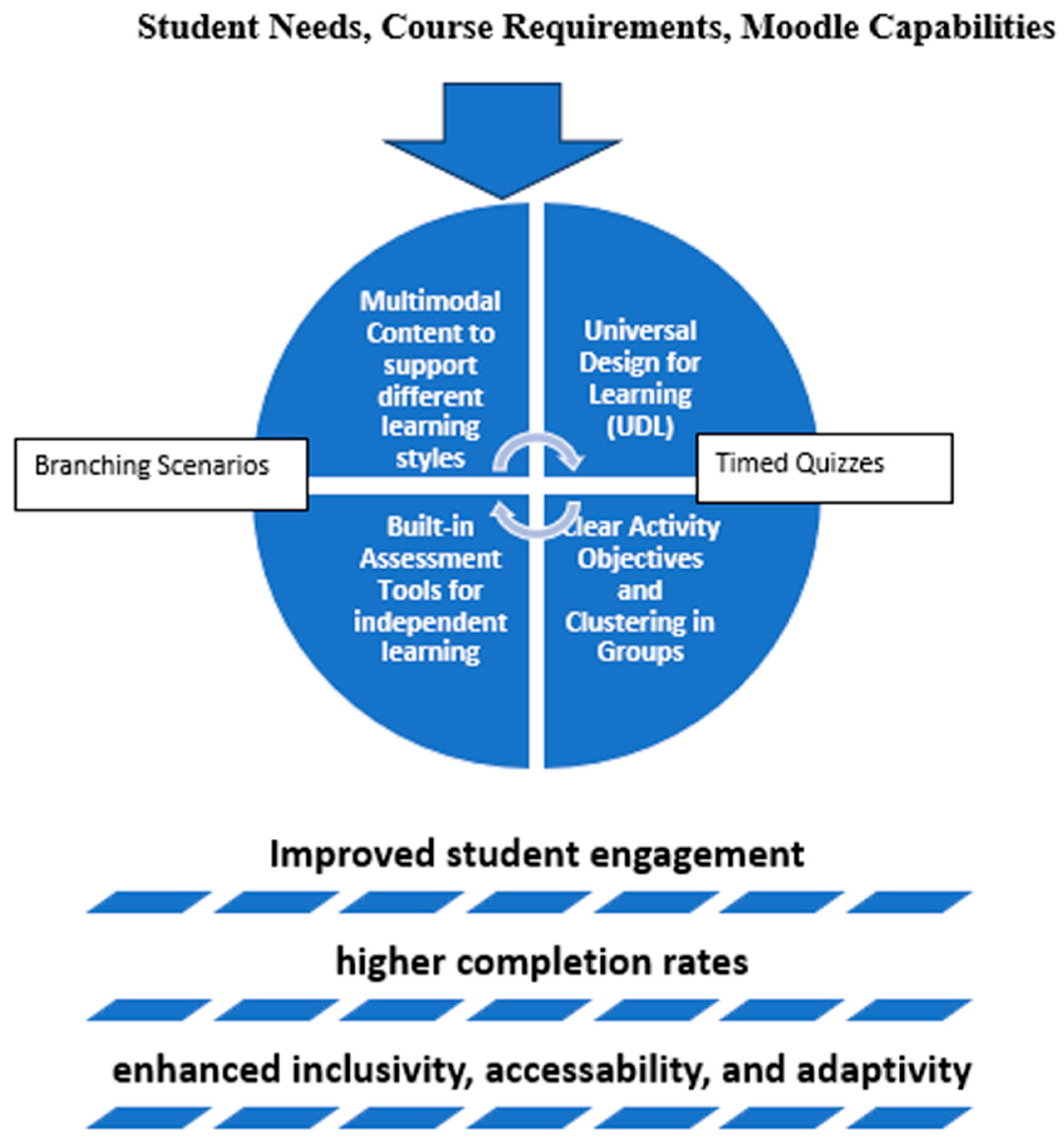
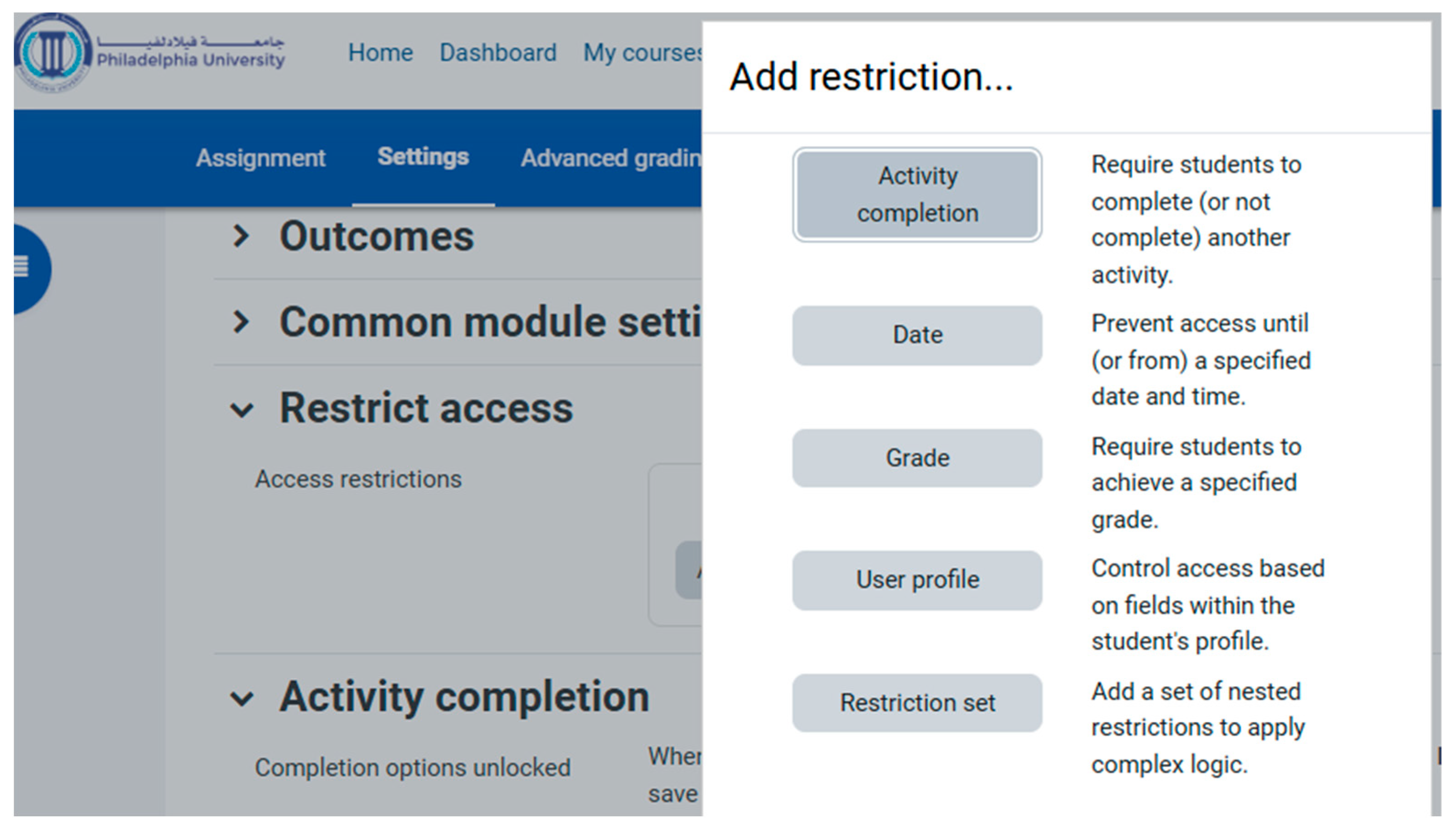
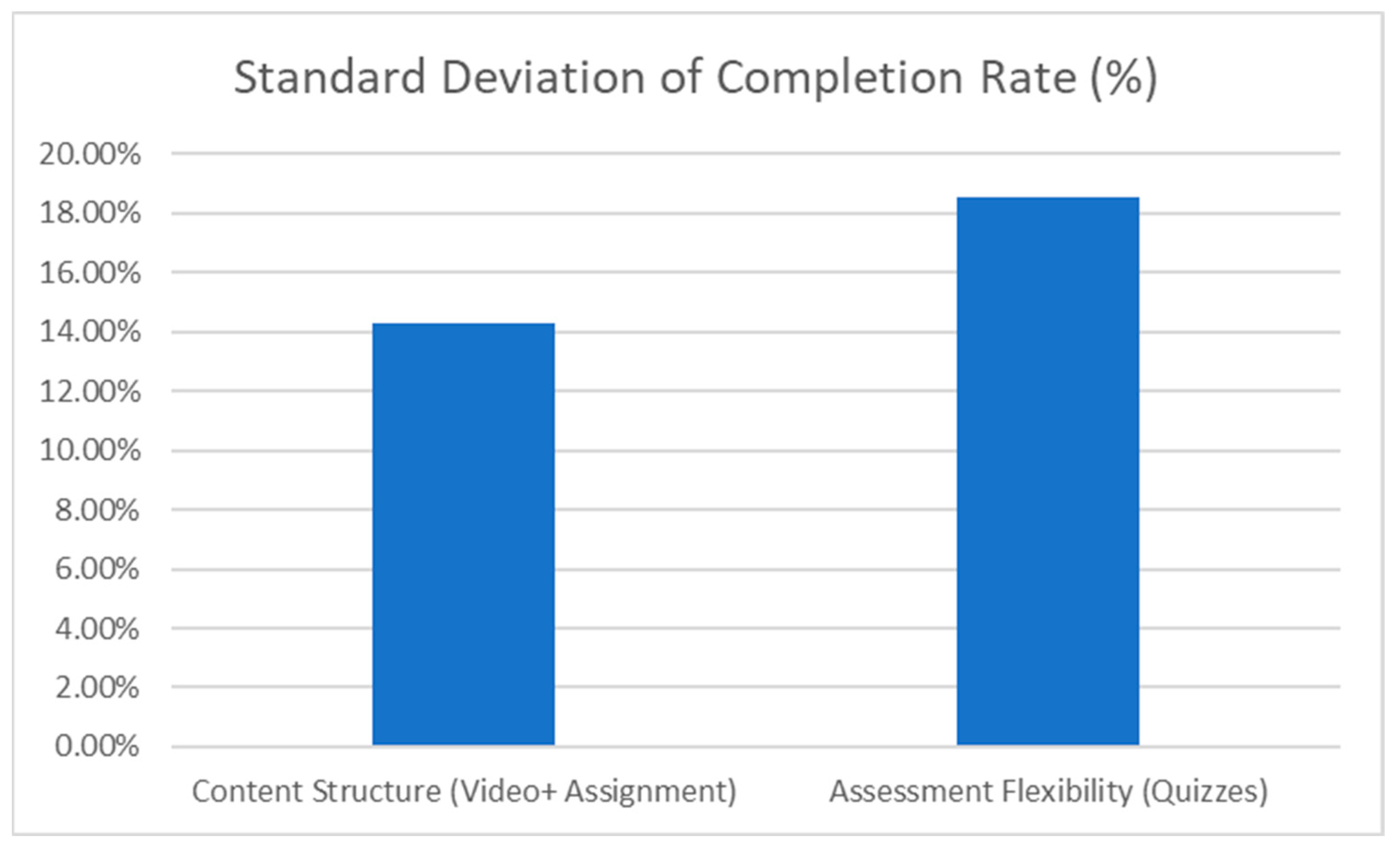
| Group | Number | Gender (M/F) | Years of Experience | Notes |
|---|---|---|---|---|
| BSc Students | 70 | 43 M and 27 F | N/A | Enrolled in software engineering course |
| Educators | 16 | 9 M and 7 F | 4–17 years | Across two Jordanian higher education institutions |
| Theme | Data Source | Code Category | Example Insights |
|---|---|---|---|
| Barriers to engaging learners in blended learning environments | Teaching Reflections and Focus Groups | Engagement Issues | Low completion rates for multimedia content; students like interactive content; did not complete assignments |
| Barriers to engaging learners in blended learning environments | Teaching Reflections and Focus Groups | Accessible Content | Timed quizzes with strict deadlines caused stress; three short videos made a distraction; students with learning challenges struggle with deadlines |
| Educators’ readiness and preparedness | Teaching Reflections and Focus Groups | Educators’ Challenges | Lack of training on Moodle’s accessibility and inclusive tools; redesigning the content was time-consuming |
| Educators’ perceptions of Moodle’s adaptability and inclusive features | Educator Interviews | Understanding of Inclusive Learning | Inclusive learning means building suitable content for all students; Moodle supports inclusivity, but requires training |
| Educators’ readiness and preparedness | Educator Interviews | Challenges with Moodle Tools | No knowledge of accessibility and inclusive features; Moodle lacks built-in tools that support adaptivity |
| Best practices for designing inclusive and adaptive blended learning | Educator Interviews | Best Practices for Inclusive and Adaptive Blended Learning | Providing flexibility in deadlines improved students’ performance; adaptive quizzes and branching scenarios work well for students who are struggling |
| Scenarios | Did Not Complete (Incl. No Response) | Completed Successfully | No Response | Completion Rate (%) |
|---|---|---|---|---|
| 3 videos (5 min each) + 1 Assignment | 40 (10 did not respond) | 30 | 10 | 42.9% |
| 1 video (15 min) + 1 Assignment | 20 | 50 | 0 | 71.4% |
| Timed quizzes (Strict Deadlines) | 29 (18 did not respond) | 41 | 18 | 58.6% |
| Timed Quizzes (Flexible Deadlines) | 3 | 67 | 0 | 95.7% |
Disclaimer/Publisher’s Note: The statements, opinions and data contained in all publications are solely those of the individual author(s) and contributor(s) and not of MDPI and/or the editor(s). MDPI and/or the editor(s) disclaim responsibility for any injury to people or property resulting from any ideas, methods, instructions or products referred to in the content. |
© 2025 by the authors. Licensee MDPI, Basel, Switzerland. This article is an open access article distributed under the terms and conditions of the Creative Commons Attribution (CC BY) license (https://creativecommons.org/licenses/by/4.0/).
Share and Cite
Al-Qora’n, L.F.; Nganji, J.T.; Alsuhimat, F.M. Designing Inclusive and Adaptive Content in Moodle: A Framework and a Case Study from Jordanian Higher Education. Multimodal Technol. Interact. 2025, 9, 58. https://doi.org/10.3390/mti9060058
Al-Qora’n LF, Nganji JT, Alsuhimat FM. Designing Inclusive and Adaptive Content in Moodle: A Framework and a Case Study from Jordanian Higher Education. Multimodal Technologies and Interaction. 2025; 9(6):58. https://doi.org/10.3390/mti9060058
Chicago/Turabian StyleAl-Qora’n, Lamis F., Julius T. Nganji, and Fadi M. Alsuhimat. 2025. "Designing Inclusive and Adaptive Content in Moodle: A Framework and a Case Study from Jordanian Higher Education" Multimodal Technologies and Interaction 9, no. 6: 58. https://doi.org/10.3390/mti9060058
APA StyleAl-Qora’n, L. F., Nganji, J. T., & Alsuhimat, F. M. (2025). Designing Inclusive and Adaptive Content in Moodle: A Framework and a Case Study from Jordanian Higher Education. Multimodal Technologies and Interaction, 9(6), 58. https://doi.org/10.3390/mti9060058






